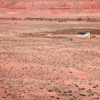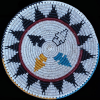
In general terms, a fetish is a small, material object that is believed to impart special strength, power, or attributes to the person carrying it. In many indigenous cultures, fetishes are made from naturally occurring materials whose shapes often resemble or represent various animals. Fetishes can also be produced by makers and in these cases can take different forms including masks, prayer plumes, and amulets, as well as fetish animals that are small enough to fit in the palm of one's hand. It is believed that when the fetish is in contact with a person's body it shares with its user the strength, power, and characteristics of the animal or natural form it represents. For example, a bear fetish would be used by a healer, a teacher, or a leader, because the bear is believed to possess the courage and strength necessary to persevere in the face of adversity, as well as to have the patience and wisdom to heal, to reflect and meditate for long periods of time, and to remain grounded. Frog fetishes, on the other hand, might be used by those interested in starting a family or those who desire change, as frogs are known for their fertility, as well as their ability to start over and to transform (from tadpole to adult amphibian).
Colors, directions, and even materials also influence the kind and amount of power a fetish can impart to its wearer. Depending upon the particular cultural tradition, both the production as well as the use of a fetish entail a range of ceremonial procedures. For example, the Zuni rituals surrounding the making, protecting, and wearing of kachina masks are an excellent example of the need for strict ceremonial secrecy and observances associated with a fetish. The Zuni masks are cared for by individual clans throughout the year, and when the time comes to use them during a ceremony their power is so great that the wearer actually becomes the god/natural force the mask represents.










